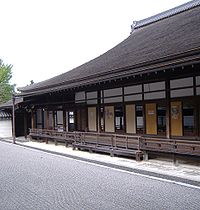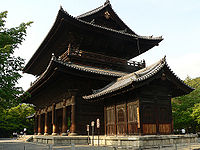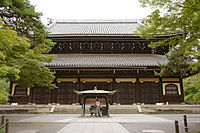- Nanzen-ji
-
Nanzen-ji (南禅寺 Nanzen-ji), or Zuiryusan Nanzen-ji, formerly Zenrin-ji (禅林寺 Zenrin-ji), is a Zen Buddhist temple in Kyoto, Japan.[1] Emperor Kameyama established it in 1291 on the site of his previous detached palace. It is also the headquarters of the Nanzen-ji branch of Rinzai Zen. Zenkei Shibayama, who provided a popular commentary on the Mumonkan, was an abbot of the monastery.
Contents
History
Nanzen-ji was founded in the middle Heian period.[2] Nanzen-ji is not itself considered one of the "five great Zen temples of Kyoto"; however, it does play an important role in the "Five Mountain System" which was modified from Chinese roots. Tenryū-ji (天龍寺 Tenryū-ji) is considered to be one of the so-called Kyoto Gozan (京都五山 Kyoto gozan) or "five great Zen temples of Kyoto", along with Shokoku-ji (相国寺 Shokoku-ji), Kennin-ji (建仁寺 Kennin-ji), Tofuku-ji (東福寺 Tofuku-ji), and Manju-ji (満寿寺 Manju-ji). The head temple presiding over the Gozan in Kyoto is Nanzen-ji.[3] After the completion of Shōkoku-ji by Ashikaga Yoshimitsu in 1386, a new ranking system was created with Nanzen-ji at the top and in a class of its own. Nanzen-ji had the title of "First Temple of The Land" and played a supervising role.[4]
Nanzen-ji Kyoto Kamakura First Rank Tenryū-ji Kenchō-ji Second Rank Shōkoku-ji Engaku-ji Third Rank Kennin-ji Jufuku-ji Fourth Rank Tōfuku-ji Jōchi-ji Fifth Rank Manju-ji Jōmyō-ji See also
- Ishikawa Goemon
- List of Buddhist temples in Kyoto
- List of National Treasures of Japan (temples)
- List of National Treasures of Japan (ancient documents)
- For an explanation of terms concerning Japanese Buddhism, Japanese Buddhist art, and Japanese Buddhist temple architecture, see the Glossary of Japanese Buddhism.
Notes
- ^ Iwao, Seiichi et al. (2002). Dictionnaire historique du Japon, p. 1976.
- ^ Ponsonby-Fane, Richard. (1956). Kyoto: The Old Capital of Japan, 794-1869, p. 154.
- ^ Baroni, Helen Josephine. (2002). The Illustrated Encyclopedia of Zen Buddhism, p. 116.
- ^ Dumoulin, Heinrich. (2005). Zen Buddhism: A History (Vol. II: Japan), pp. 151-153.
References
- Baroni, Helen Josephine. (2002). The Illustrated Encyclopedia of Zen Buddhism. New York: Rosen Publishing Group. 10-ISBN 0823922405; 13-ISBN 9780823922406; OCLC 42680558
- Dumoulin, Heinrich. (2005). Zen Buddhism: A History (Vol. II: Japan). Bloomington, Indiana: World Wisdom. 10-ISBN 0-941-53290-9; 13-ISBN 978-0-941-53290-7
- Iwao, Seiichi, Teizō Iyanaga, Susumu Ishii, Shōichirō Yoshida et al. (2002). Dictionnaire historique du Japon (Vol. II). Paris: Maisonneuve & Larose. 10-ISBN 2-706-81632-5; 13-ISBN 978-2-706-81632-1; OCLC 51096469
- Ponsonby-Fane, Richard Arthur Brabazon. (1956). Kyoto: The Old Capital of Japan, 794-1869. Kyoto: The Ponsonby Memorial Society.
External links
- Nanzen-ji official web site
- Kyoto Prefectural Tourism Guide: Nanzen-ji
- Joint Council for Japanese Rinzai and Obaku Zen: Nanzen-ji
- Sacred Destinations: Nanzen-ji, Kyoto;
- Buddhist Travel: Nanzen-ji
Buddhism Buddhism portal Buddhist temples in Japan Japanese Buddhist architecture Architectonic elements Mon (gates) Buildings Chinjusha · chōzuya/temizuya · -dō · main hall (kon-dō, hon-dō, butsuden) · kuri · kyōzō or kyō-dō · shoinTō or Buttō (pagodas) Styles Others A-un · kenSchools and objects of worship Major schools Zen schools Nanto rokushū Objects of worship Amida Nyōrai · Benzaiten · Dainichi Nyorai · Jizō · Kannon · Marishi-ten · Shaka Nyorai · Shitennō (Four Kings) · Twelve Heavenly Generals (Jūni Shinshō) · Yakushi NyoraiOther elements Implements Others bussokuseki · butsudan · Glossary of Japanese Buddhism · Japanese Buddhist pantheon · jingū-ji · miyadera · saisenbakoCoordinates: 35°00′40″N 135°47′39″E / 35.01111°N 135.79417°E
Categories:- 1291 establishments
- Buddhist temples in Kyoto Prefecture
- National Treasures of Japan
- Rinzai temples
- Places of Scenic Beauty
Wikimedia Foundation. 2010.




